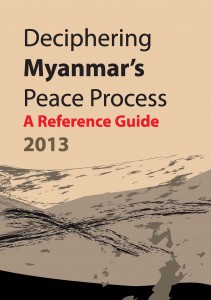Deciphering Myanmar’s Peace Process: A Reference Guide
By Burma News International • January 30, 2013The new nominally civilian government is making serious efforts to achieve peace in Myanmar after more than 60 years of civil war. Peace is critical for ending human suffering and achieving stability; a precondition for overcoming poverty, ensuring long term development and protecting human rights. Most importantly, peace is essential for implementing a stable democracy. In 2015, Myanmar will become a full member of the ASEAN community in which it is responsible to meet the standards outlined in the ASEAN charter.
Although all sides want the confl ict to end, achieving peace is no easy task. The protracted civil war in Myanmar is complicated not only by the sheer number of ethnic armed groups who are competing for regional and domestic interests, but also from the lack of trust and misunderstandings resulting from poor communication and transparency on all sides. Therefore it is crucial to carefully monitor the peace process to improve understanding and clarity necessary for establishing lasting peace.
This book serves as a reference guide for media outlets and stakeholders involved in the peace process. It provides an overall picture of the problems resulting from the ongoing conflicts, identifies the root causes that need to be addressed and maps out the entire structure of the peace plan. By identifying all the key actors, their interests and activities for peace, it becomes possible to make sense of the complicated relationships, as well as points of convergence and conflict related to their activities. In this sense, the information compiled in this book will help readers locate actors and events that form the larger picture to understand how they are interconnected in the peace process.
Click here to download the full report.
Tags: Armed Conflict, Burma Army, Burma News International, Ethnic Nationalities, Peace ProcessThis post is in: Ethnic Nationalities, Spotlight
Related PostsBurma Army Displays Blatant Disregard for 21st Century Panglong Peace Process
On Union Day, Reappraisal of the Peace Process is Needed
ရွမ္းျပည္တိုိးတက္ေရးပါတီ၊ ရွမ္းျပည္တပ္မေတာ္ SSPP/SSA ထုတ္ျပန္ေၾကညာခ်က္
Time for the Government to Accept the Reality of Human Rights Problems, Take Effective Measures and Move Forward
Kachin Region: War Torn Displaced Village Profiles










 All posts
All posts